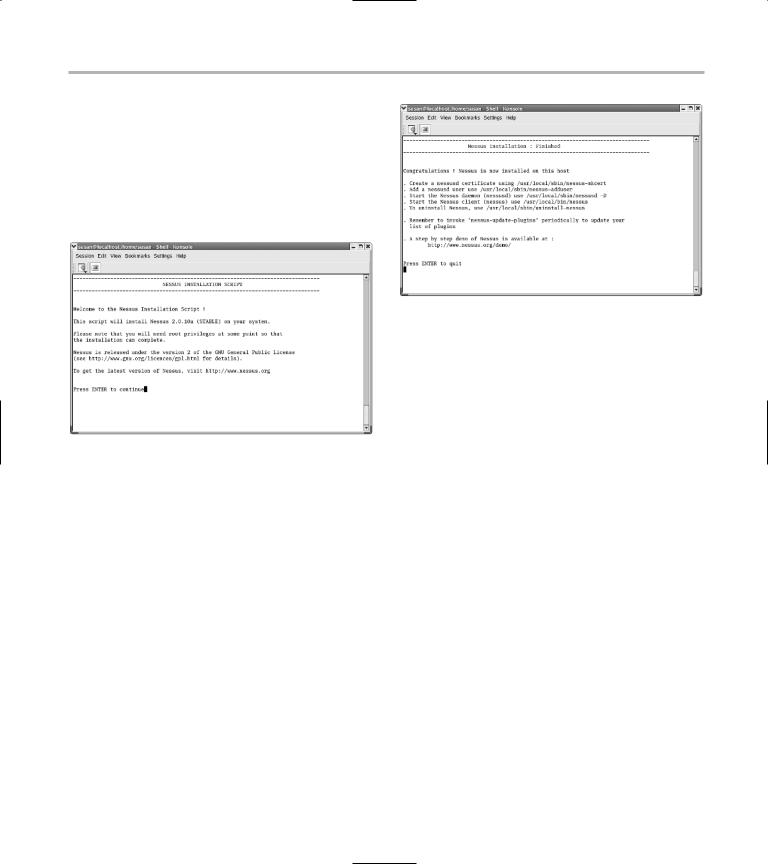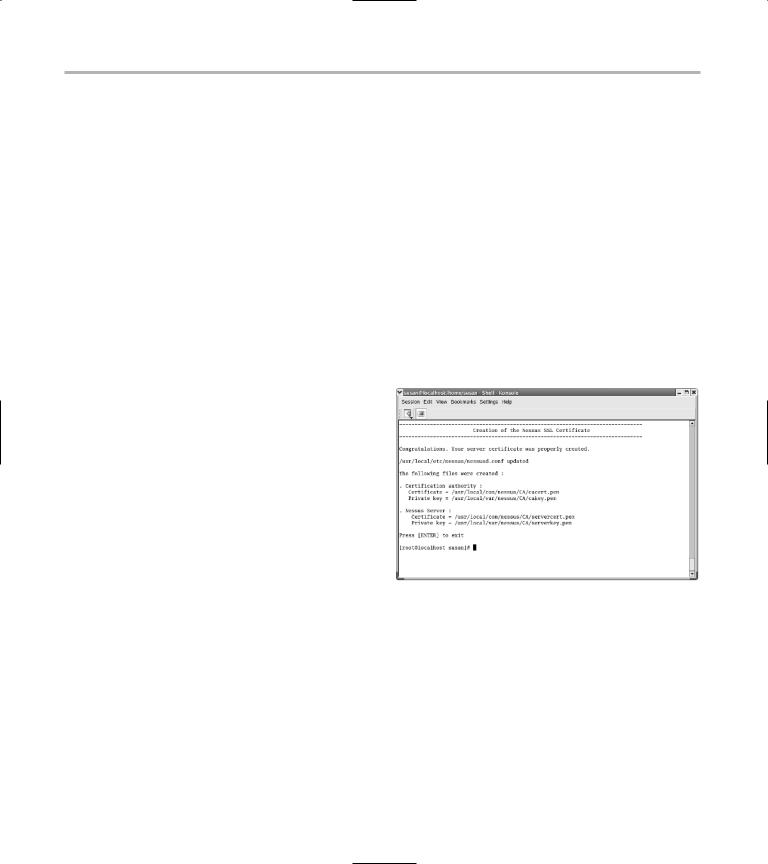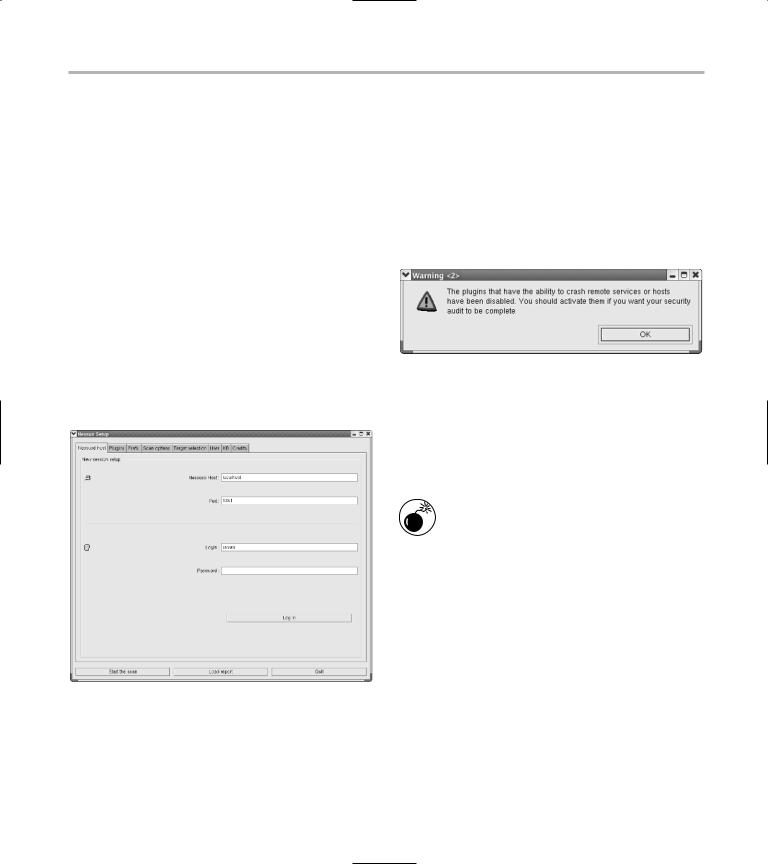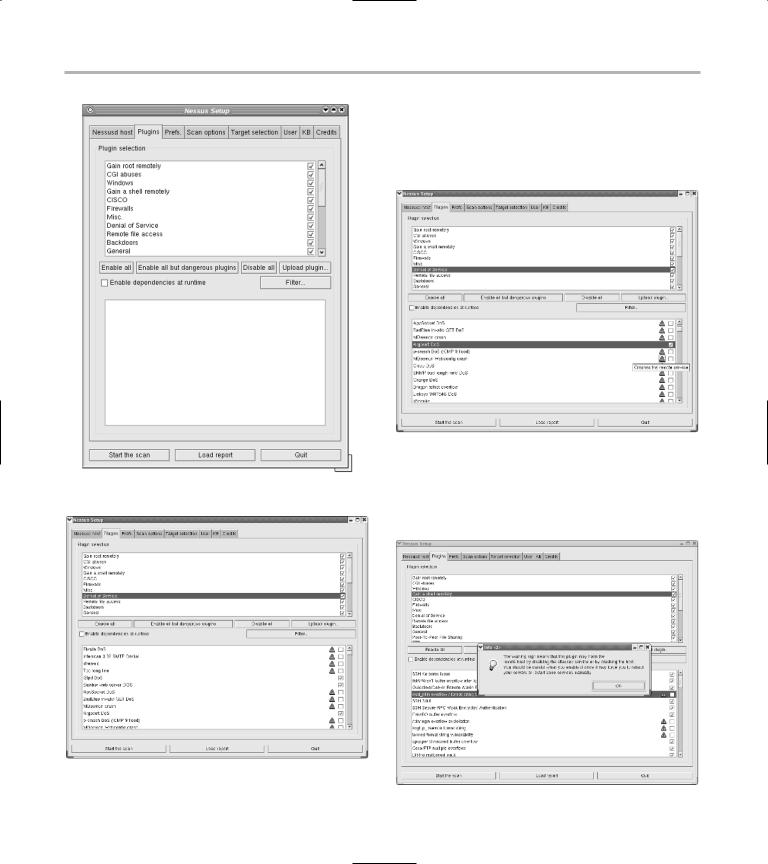
- •Table of Contents
- •Introduction
- •Saving Time with This Book
- •Foolish Assumptions
- •Part I: Making the Desktop Work for You
- •Part II: Getting the Most from Your File System
- •Part III: Good Housekeeping with Linux
- •Part IV: Tweaking the Kernel on Your Linux System
- •Part V: Securing Your Workspace
- •Part VI: Networking Like a Professional
- •Part VII: Monitoring Your System
- •Part VIII: Serving Up the Internet and More
- •Part X: Programming Tricks
- •Part XI: The Scary (Or Fun!) Stuff
- •Icons Used in This Book
- •Discovering Your Protocols
- •Managing Snapshots with the camera: Protocol
- •Remote File Management with fish:
- •Getting Help with help:, info:, and man:
- •Other KDE Protocols
- •Using GNOME VFS Modules
- •Stacking VFS Modules
- •Working with Packages: rpm and rpms
- •Putting VFS to Work at the Command Line
- •Burning CDs with a VFS
- •Skinning Your Desktop with VFS
- •Classifying Data with MIME
- •Creating KDE File Associations
- •Creating New MIME Types with GNOME
- •Making Basic Prompt Transformations
- •Adding Dynamically Updated Data to Your Prompt
- •Colorizing Your Prompt
- •Seeing a Red Alert When You Have Superuser Privileges
- •Saving Your Work
- •Completing Names Automatically
- •Using the Escape Key to Your Advantage
- •Customizing Completion for Maximum Speed
- •Using cd and ls to Navigate through bash
- •Setting Your CDPATH Variables to Find Directories Fast
- •Streamlining Archive Searches
- •Turning the Output of a Command into a Variable with $( )
- •Using $UID and $EUID in Shell Scripts
- •Customizing Variables for Rapid Transit
- •Finding the Right Shell Script
- •Choosing your victims
- •Timing is everything
- •Cleaning up made easy
- •Changing prototype scripts
- •Customizing Your Autostart File
- •Navigating the History List
- •Scrolling
- •Summoning a command by number
- •Searching through history
- •Customizing the History List
- •Adjusting key default settings
- •Filtering the history list
- •Executing Commands Quickly with History Variables
- •Viewing Your Aliases
- •Using Aliases for Complex Commands
- •Automating Tedious Tasks with Functions
- •Filtering file searches by file type
- •Automatic downloading
- •Monitoring Your System in a Snap
- •Un-tarring the Easy Way
- •What Is Samba?
- •Getting Up and Running with Samba
- •Checking whether Samba is installed
- •Enabling Samba
- •Adjusting the workgroup name and creating user accounts
- •Giving a Windows machine access to your home directory
- •Sharing Linux files and directories with other computers
- •Hooking Everyone Up to the Printer
- •Sharing Linux printers with SWAT
- •Using a Windows printer from Linux
- •Plugging In to Remote Data with Linux Programs Quickly
- •Finding Files with locate
- •Finding Files with find
- •Qualifying Your Search with the find Command
- •Doing updated filename searches
- •Adding time-based qualifications
- •Filtering by file size
- •Perusing commonly used qualifications
- •Acting on What You Find
- •Displaying specific info with -printf
- •Checking disk usage by user
- •Executing commands with find
- •Building Complex Commands with xargs
- •Creating Archives with File Roller
- •Inspecting and Extracting Archives with File Roller
- •Adding Functionality to tar with Complex Commands
- •Building archives from the command line
- •Archiving complex search results
- •Backing up an installed package
- •Uprooting Entire Directory Trees with scp
- •Splitting Big Files into Manageable Chunks
- •Building Software from Downloaded tarballs
- •Compiling a tarball: The basic steps
- •Downloading and compiling SuperKaramba
- •Versatile Downloading with wget
- •Mirroring sites with wget
- •Verifying your bookmarks with wget
- •Downloading files with wget
- •Downloading and unpacking in one quick step
- •Downloading and Uploading with curl
- •Setting Up ADIOS
- •Downloading ADIOS
- •Burning ADIOS to CD
- •Installing ADIOS
- •Finding Your Way around UML
- •Connecting to the Internet from an ADIOS VM
- •Using a GUI with UML
- •Installing Software into UML
- •Merging Changes to Your Prototype
- •Querying RPM Packages for Content
- •Digesting Information
- •Creating a Package Index
- •Querying for Prerequisites
- •Dissecting an RPM Package
- •Using RPM at the Command Line
- •Removing RPMs
- •Flagging Down RPM
- •Getting Graphic with RPM
- •Using Rpmdrake to install from media
- •Installing from your Konqueror browser
- •Verifying Your System
- •Reading the Tamper-Proof Seal
- •Setting Up Synaptic and apt in a Snap
- •Keeping Up-to-Date with apt and Synaptic: The Basics
- •Handy Hints about Synaptic
- •Changing repositories
- •Viewing package details
- •Installing new packages with Synaptic
- •Importing the Keys to the Repository
- •Letting Task Scheduler Work for You
- •Scheduling a new task
- •Editing a task
- •Adding environment variables
- •Reining In Resources with Disk Quotas
- •Installing the quota RPM package
- •Enabling file system quotas
- •Getting your files together
- •Setting quotas
- •Reviewing your quotas
- •Using System Accounting to Keep Track of Users
- •Setting up system accounting
- •Looking up user login hours
- •Checking out command and program usage
- •Running Down the Runlevels
- •Runlevel basics
- •Customizing runlevels in Fedora
- •Customizing runlevels in SuSE
- •Customizing runlevels in Mandrake
- •Customizing runlevels at the command line
- •Switching to a new runlevel
- •Disabling Unused Services
- •Removing Unneeded Services
- •Learning about modules
- •Installing a module with insmod
- •Taking care of dependencies automatically with modprobe and depmod
- •Loading a module for a slightly different kernel with insmod and modprobe
- •Removing modules with rmmod
- •Step 1: Making an Emergency Plan, or Boot Disk
- •Step 2: Finding the Source Code
- •Step 4: Customizing the Kernel
- •Step 5: Building the Kernel
- •Understanding the Principles of SELinux
- •Everything is an object
- •Identifying subjects in SELinux
- •Understanding the security context
- •Disabling or Disarming SELinux
- •Playing the Right Role
- •Exploring the Process-Related Entries in /proc
- •Surveying Your System from /proc
- •Popping the Cork: Speeding Up WINE with /proc
- •Reading and Understanding File Permissions
- •Controlling Permissions at the Command Line
- •Changing File Permissions from a Desktop
- •Encryption Made Easy with kgpg and the KDE Desktop
- •Creating keys with kgpg
- •Sharing your key with the world
- •Importing a public key from a public-key server
- •Encrypting and decrypting documents with drag-and-drop ease
- •Encrypting Documents with gpg at the Command Line
- •Sharing a secret file
- •Creating a key pair and receiving encrypted documents
- •Encrypting documents on your home system
- •Encrypting E-Mail for Added Security
- •Encrypting with Ximian Evolution
- •Setting up Mozilla e-mail for encryption
- •Sending and receiving encrypted messages with Mozilla mail
- •Using Cross-Platform Authentication with Linux and Windows
- •Prepping for cross-platform authentication
- •Setting up cross-platform authentication
- •Using PAM and Kerberos to Serve Up Authentication
- •Establishing synchronized system times
- •Testing your domain name server (DNS)
- •Setting up a Key Distribution Center
- •Setting up automatic ticket management with Kerberos and PAM
- •Adding users to the Key Distribution Center
- •Building Good Rules with PAM
- •Phase
- •Control level
- •Module pathname
- •Arguments
- •Dissecting a Configuration File
- •Skipping a Password with PAM
- •Feeling the Power
- •Gaining Superuser Privileges
- •Pretending to Be Other Users
- •Limiting Privileges with sudo
- •Installing sudo
- •Adding Up the Aliases
- •Adding Aliases to the sudo Configuration File
- •Defining the Alias
- •Creating a User_Alias
- •Creating a Runas_Alias
- •Simplifying group managment with a Host_Alias
- •Mounting and unmounting CDs without the superuser password
- •Managing access to dangerous commands with command aliases
- •Using SSH for Top-Speed Connections
- •Setting Up Public-Key Authentication to Secure SSH
- •Generating the key pair
- •Distributing your public key
- •Passing on your passphrase
- •Logging In with SSH and Key Authentication
- •Starting from the command line
- •Getting graphic
- •Creating Shortcuts to Your Favorite SSH Locations
- •Copying Files with scp
- •Secure (And Fast) Port Forwarding with SSH
- •Finding Your Firewall
- •Setting up a simple firewall in Mandrake Linux
- •Setting up a simple firewall in Fedora Linux
- •Setting up a simple firewall in SuSE Linux
- •Editing the Rules with Webmin
- •Starting a Webmin session
- •Reading the rules with Webmin
- •Changing the rules
- •Editing existing rules
- •Adding a new rule with Webmin
- •Sharing Desktops with VNC
- •Inviting Your Friends to Use Your Desktop
- •Serving Up a New Desktop with VNC Server
- •Using tsclient to View Remote Desktops from Linux
- •Using tsclient with a VNC server
- •Using tsclient with an RDP server
- •Creating New VNC Desktops on Demand
- •Switching display managers in SuSE Linux
- •Switching display managers in Mandrake Linux
- •Connecting gdm and VNC
- •Exploring Your Network with lsof
- •Running lsof
- •Interpreting the lsof output
- •Reading file types
- •Discovering Network Connections
- •Other Timesaving lsof Tricks
- •Packet Sniffing with the Ethereal Network Analyzer
- •Starting Ethereal
- •Capturing packets
- •Applying filters to screen packets
- •Peeking in packets
- •Color-coding packets coming from your network
- •Getting Up and Running with Nessus
- •Installing programs Nessus needs to run
- •Installing Nessus
- •Adding a user to Nessus
- •Generating a certificate
- •Starting the daemon and the interface
- •Reading the grim results
- •Keeping Your Plug-ins Up-to-Date
- •Chatting in the Fedora Chat Room
- •Looking for Answers in the SuSE Chat Room
- •Processing Processes with procps
- •Using ps to filter process status information
- •Viewing ps output the way you want to see it
- •Making parent-child relationships stand out in a ps listing
- •Climbing the family tree with pstree
- •Finding processes with pgrep
- •Killing Processes with pkill
- •Killing Processes with killall
- •Closing Windows with xkill
- •Managing Users and Groups with the Fedora/Mandrake User Manager
- •Adding new users
- •Modifying user accounts
- •Adding groups
- •Filtering users and groups
- •Managing Users and Groups with the SuSE User Administrator
- •Adding new users
- •Modifying user accounts
- •Adding groups
- •Filtering users and groups
- •Adding and deleting log files from the viewer
- •Setting up alerts and warnings
- •Viewing your log files from SuSE
- •Monitoring your log files from SuSE
- •Customizing Your Log Files
- •Keeping an Eye on Resources with KDE System Guard
- •Finding and killing runaway processes
- •Prioritizing processes to smooth a network bottleneck
- •Watching your system load
- •Creating a new worksheet
- •Creating system resource logs
- •Displaying network resources
- •Using Synaptic to download and install Apache
- •Installing Apache from disc
- •Starting the Apache Service
- •Building a Quick Web Page with OpenOffice.org
- •Taking Your Site Public with Dynamic DNS
- •Understanding how dynamic DNS works
- •Setting up dynamic DNS
- •Updating your IP address
- •Installing the Fedora HTTP Configuration tool
- •Putting the HTTP Configuration tool to work
- •Watching Your Web Server Traffic with apachetop
- •Installing apachetop
- •Running and exiting apachetop
- •Navigating apachetop
- •Switching among the log files (or watching several at once)
- •Changing the display time of apachetop statistics
- •Accessing MySQL Control Center features
- •Viewing, managing, and repairing a database with the Databases controls
- •Putting the Server Administration controls to work
- •Adding a new user
- •Watching Your MySQL Traffic with mtop
- •Gathering all the packages that mtop needs
- •Installing mtop
- •Monitoring traffic
- •Building a MySQL Server
- •Installing the necessary packages
- •Starting the MySQL server
- •Replicating MySQL Data
- •Configuring replication: The three topologies
- •Setting up replication for a single slave and master
- •Choosing a Method to Back Up MySQL Data
- •Backing Up and Restoring with mysqldump
- •mysqldump backup options
- •Backing up multiple databases
- •Compressing the archive
- •Restoring a mysqldump archive
- •Making a mysqlhotcopy of Your Database
- •Archiving a Replication Slave
- •Taking Care of Business with MySQL Administrator
- •Installing MySQL Administrator
- •Starting MySQL Administrator
- •Choosing an SSL Certificate
- •Creating a Certificate Signing Request
- •Creating a Signing Authority with openssl
- •Creating a certificate authority
- •Signing a CSR
- •Exploring Your Certificate Collection with Mozilla
- •Introducing hotway
- •Getting Started with hotway
- •Setting Up Evolution to Read HTTPMail Accounts with hotway
- •Ringing the Bells and Blowing the Whistles: Your Evolution Summary Page
- •Installing SpamAssassin
- •Installing from the distribution media
- •Installing from RPM downloads
- •Starting the service
- •Fine-Tuning SpamAssassin to Separate the Ham from the Spam
- •Customizing settings
- •Saving your settings
- •Adding a New Filter to Evolution
- •Serving Up a Big Bowl of the RulesDuJour
- •Registering Your Address
- •Taming a Sendmail Server
- •Tweaking Your Configuration Files with Webmin
- •Serving up mail for multiple domains
- •Relaying e-mail
- •Using aliases to simplify mail handling
- •Deciding What to Archive
- •Choosing Archive Media
- •Tape drives
- •Removable and external disk drives
- •Removable media
- •Optical media (CDs and DVDs)
- •Online storage
- •Choosing an Archive Scheme
- •Full backups
- •Differential backups
- •Incremental backups
- •Incremental versus differential backups
- •Choosing an Archive Program
- •Estimating Your Media Needs
- •Creating Data Archives with tar
- •Backing up files and directories
- •Backing up account information and passwords
- •Targeting bite-sized backups for speedier restores
- •Rolling whole file systems into a tarball
- •Starting an Incremental Backup Cycle
- •Restoring from Backup with tar
- •Backing Up to CD (Or DVD) with cdbackup
- •Creating the backup
- •Restoring from a CD or DVD backup
- •Restoring from a disc containing multiple archives
- •Combining the Power of tar with ssh for Quick Remote Backups
- •Testing the ssh connection to the remote host
- •Creating a tar archive over the ssh connection
- •Backing up to tape drives on remote machines
- •Backing Up to a Remote Computer with rdist and ssh
- •Testing the ssh connection to the remote host
- •Creating the distfile
- •Backing up
- •Getting Started with CVS
- •Checking whether CVS is installed
- •Discovering what to use CVS for
- •Creating a CVS Repository
- •Populating Your Repository with Files
- •Simplifying CVS with cervisia
- •Installing cervisia
- •Putting files in your sandbox
- •Adding more files to your repository
- •Committing your changes
- •Browsing your log files
- •Marking milestones with tags
- •Branching off with cervisia
- •Using the libcurl Library (C Programming)
- •Uploading a File with a Simple Program Using libcurl
- •Line 7: Defining functions and data types
- •Line 14: Calling the initialization function
- •Lines 18– 21: Defining the transfer
- •Line 23: Starting the transfer
- •Line 26: Finishing the upload
- •Installing the Ming Library
- •Building a Simple Flash Movie with Ming
- •Examining the program
- •Compiling the program
- •Running the program
- •Building Interactive Movies with Ming
- •Examining the program
- •Compiling the program
- •Running the program
- •Doing the curl E-shuffle with PHP
- •Combining PHP with curl and XML: An overview
- •Checking out the XML file
- •Downloading and displaying the XML file with a PHP script (and curl)
- •Sending E-Mail from PHP When Problems Occur
- •Debugging Perl Code with DDD
- •Installing and starting DDD
- •Examining the main window
- •Reviewing and stepping through source code
- •Making Stop Signs: Using Breakpoints to Watch Code
- •Setting a breakpoint
- •Modifying a breakpoint
- •Opening the data window
- •Adding a variable to the data window
- •Changing the display to a table
- •Using the Backtrace feature
- •Using the Help menu
- •Making Fedora Distribution CDs
- •Downloading the ISO images
- •Verifying the checksums
- •Burning an ISO File to Disc at the Command Line
- •Finding the identity of your drive
- •Running a test burn
- •Burning the distribution discs
- •Burning CDs without Making an ISO First
- •Finding setuid quickly and easily with kfind
- •Finding setuid and setgid programs at the command line
- •Deciding to Turn Off setuid or setgid
- •Changing the setuid or setgid Bit
- •Who Belongs in Jail?
- •Using UML to Jail Programs
- •Using lsof to Find Out Which Files Are Open
- •Debugging Your Environment with strace
- •Investigating Programs with ltrace
- •Handy strace and ltrace Options
- •Recording Program Errors with valgrind
- •Hardening Your Hat with Bastille
- •Downloading and installing Bastille and its dependencies
- •Welcome to the Bastille
- •Addressing file permission issues
- •Clamping down on SUID privileges
- •Moving on to account security
- •Making the boot process more secure
- •Securing connection broker
- •Limiting compiler access
- •Limiting access to hackers
- •Logging extra information
- •Keeping the daemons in check
- •Securing sendmail
- •Closing the gaps in Apache
- •Keeping temporary files safe
- •Building a better firewall
- •Port scanning with Bastille
- •Turning LIDS On and Off
- •Testing LIDS before Applying It to Your System
- •Controlling File Access with LIDS
- •Hiding Processes with LIDS
- •Running Down the Privilege List
- •Getting Graphical at the Command Line
- •Getting graphical in GNOME
- •Getting graphical with KDE
- •Staying desktop neutral
- •Index

256 Technique 37: Evaluating Your Network Security with Nessus
In this technique, we show you how to use Nessus to evaluate your network security. It’s a great tool that’s easy to use, and the time you save by finding security loopholes before the hackers do will definitely justify the time spent investigating your network security.
Getting Up and Running with Nessus
Setting up Nessus is a matter of a few simple steps. Before you can use Nessus, you need to do the following:
1. Satisfy its dependencies by installing the other programs that Nessus needs to run.
2. Compile and install the Nessus files.
3. Create a user identity.
4. Create an SSL certificate to ensure that the
Nessus transactions are all handled securely on your system.
Follow along, and you’ll be up and running in no time!
Installing programs Nessus needs to run
Nessus has a couple of prerequisites — you need to have GTK (the Gimp Toolkit) installed on your system, as well as the sharutils RPM package. If you’ve installed the GNOME desktop environment, GTK is included. If not, you need to install it.
You can install GTK from your distribution media:
1. Open a terminal window and gain superuser privileges with the su command. Then move to the directory containing the RPM packages.
2. Type the following command and press Enter:
# rpm -Uhv gtk2-version.rpm
You also need the sharutils package, which is included with most Linux distributions.
3. To install sharutils, type the following command and press Enter:
# rpm -Uhv sharutils-version.i386
After sharutils installs, you’ve satisfied the dependencies for the Nessus program.
Using Synaptic to download a Nessus RPM package and install the dependencies is a definite timesaver. Check out Technique 19 for information about Synaptic.
Installing Nessus
Now that the program dependencies have been met, you’re ready to download and install Nessus. To download the latest version of Nessus for your system, follow these steps:
1. Open a Web browser and surf to
www.nessus.org/download.html
2. Click the link to the most recent copy of Nessus for UNIX-compatible computers.
You’re taken to a download page.
3. On the download page, scroll down to find The
Easy and Less Dangerous Way section.
4. Click the link to the server nearest to you.
5. When the new window opens, click the link for the nessus-installer.sh file.
6. Save the file to your home directory.
7. When the file is done downloading, close the download manager and the browser window.
You’ve downloaded the files, and now you need to compile and install Nessus. Fortunately, the kind programmers at Nessus have provided a pretty decent setup tool. To install Nessus, follow these steps:
The RPM for GTK installs.

Getting Up and Running with Nessus 257
1. Open a terminal window and give yourself superuser privileges with the su command.
2. Move to your home directory, type the following command, and press Enter:
# sh nessus-install.sh
The Nessus Installation Script opens, as shown in Figure 37-1.
•Figure 37-1: The Nessus Installation Script window.
3.Press Enter to continue.
The installation script begins extracting the archives and setting up shop.
4.When prompted, press Enter to accept the default location for the Nessus installation.
5.Confirm the installation with another press of the Enter key when prompted.
Nessus begins compiling the libraries and configuring the sources for your system. You may see a few warnings go by — don’t worry about them too much — they’re for the authors of the code to watch.
6.When Nessus prompts you to build libraries, answer y.
You see a window confirming that the Nessus installation is finished, as shown in Figure 37-2.
• Figure 37-2: The Nessus Installation: Finished window.
You have only a couple more steps to go before you’re ready to run Nessus. You still need to add a user and create an SSL certificate for the program.
Adding a user to Nessus
In the wrong hands, Nessus can make life miserable for a system administrator. Although most people use Nessus to scan their own networks, Nessus can be used to discover (and, to a small extent, exploit) vulnerabilities in other computers. To minimize the chances that abuse originates from your computer, Nessus keeps its own user database. Before you can use Nessus, you need to add a user and create a password:
1. Enter the following command:
# /usr/local/sbin/nessus-adduser
The Nessus Add User script starts. The questions are fairly simple and quick.
2. The script prompts you for a login. Type your user name and press Enter.
The script prompts you for a means of authentication.
3. Type pass to use password authentication or cert to use certificate authentication.

258 Technique 37: Evaluating Your Network Security with Nessus
4. Press Enter to accept the default (password) and continue.
You’re prompted to enter the login password.
5. Enter a good password (one that’s easy to remember but hard to guess).
You’re prompted to enter a set of rules for the user. Just accept the default (an empty set) and move on to Step 6.
6. Press Ctrl+D to continue.
You’re asked to confirm the entries for the new user — glance through the summary to make sure everything looks correct.
7. Press Enter to continue.
You’re done creating a user in Nessus. The last step in the setup process is creating a certificate. See the next section for details.
Generating a certificate
After you add a user for the Nessus security tool, you need to generate an SSL certificate. The Nessus server sends the SSL certificate to your Nessus client so you know that you’re connected to the real server and not someone impersonating your server for dastardly purposes. (See Technique 45 for more details on how SSL certificates safeguard your system.) To generate the server certificate, follow these steps:
1. Still at the command line, start the Nessus certificate generator by typing the following command and pressing Enter:
# /usr/local/sbin/nessus-mkcert
The answers to the following questions are used to create the security certificate.
First, you’re prompted for the CA certificate lifetime (in days).
2. Press Enter to accept the default of 1460 days, or enter another length of time.
You’re prompted for the server certificate lifetime.
3. Press Enter to accept the default.
4. Enter an appropriate, two-letter country code and press Enter when you’ve decided on a location code.
The default is France.
5. Enter your state or province and press Enter.
6. Enter your city and press Enter.
7. Enter your organization name and press Enter.
The questions are done, and your monitor should be displaying a window confirming that your SSL certificate has been created (see Figure 37-3).
8. Press Enter to exit the nessus-mkcert program and return to the command line.
• Figure 37-3: The new SSL certificate has been created.
Using Nessus to Scan
Your Network
After you download, install, and set up Nessus, add your user account, and create the SSL certificate, you’re ready to scan your network for vulnerabilities. The graphical interface makes Nessus quick to use and fairly intuitive. You’ll be scanning in no time!

Using Nessus to Scan Your Network |
259 |
You need to do the setup and installation only the first time you run Nessus. After that, you just start the daemon and the user interface each time you want to scan your system.
Starting the daemon and the interface
Nessus is a client/server program. Before you can scan other machines on your network, you need to start the Nessus daemon. To start the daemon, follow these steps:
1. Type the following command and press Enter:
#/usr/local/sbin/nessusd -D
2.To start the user interface, type this command and press Enter:
#/usr/local/bin/nessus
The Nessus Setup window opens, as shown in Figure 37-4.
•Figure 37-4: The Nessus Setup window.
3.Enter your Nessus login and password in the appropriate fields in the setup window, and then click Log In.
After validating your password, Nessus opens a dialog, offering you choices about your level of security.
4. View and approve the certificate to continue.
Nessus moves you to the Plugins tab of the Nessus Setup window.
A Warning dialog opens, warning you that volatile plug-ins have been disabled (see Figure 37-5).
• Figure 37-5: A fairly ominous-looking warning dialog.
By default, Nessus disables dangerous plug-ins that may crash the computer you scan. The warning that you see is telling you that your security audit won’t be complete without enabling the plug-ins that are a threat to your system.
If you enable the dangerous plug-ins, you may crash the target system. Are you feeling lucky today?
5. Click OK to continue.
On the Plugins tab, you see a list of the plug-ins that are currently installed on your system. They are grouped according to component type in the top frame of the window, as shown in Figure 37-6.
6. In the Plugin Selection area, highlight one of the types to display a list of the plug-ins that make up that component in the lower part of the window.
Use the scroll bar to cruise through the list. You can see that the boxes next to the plug-ins that are considered volatile are not checked, as shown in Figure 37-7.

260 Technique 37: Evaluating Your Network Security with Nessus
• Figure 37-6: The Plugins tab of the Nessus Setup window.
• Figure 37-7: The Nessus Setup window with volatile plug-ins.
7. Hover the mouse pointer over the dangerous plug-in’s warning icon (the little yellow yield sign with the ! on it) to display a tooltip that tells you what might happen to your system if you invoke this plug-in (see Figure 37-8).
•Figure 37-8: Check out the warnings.
8.Click the yield sign to display a more graphic explanation of the problems you may encounter if you enable the plug-in (see the example in Figure 37-9).
• Figure 37-9: The complete explanation.

|
Using Nessus to Scan Your Network |
261 |
|
We don’t recommend enabling dangerous |
Enable All but Dangerous Plug-ins: Don’t |
||
plug-ins unless you have a specific security |
enable the plug-ins that might cause problems |
||
need. Be sure not to probe someone else’s |
on the target systems. |
|
|
machine with a dangerous plug-in enabled |
Disable All: Disable all the plug-ins for a |
||
because some of the plug-ins can crash the |
|||
minimal scan. |
|
||
remote machine. |
|
||
9. Highlight a plug-in in the list box at the bottom |
Upload Plugin: Upload any plug-ins that you |
||
write to the Nessus server. |
|
||
of the window to display a more complete |
|
|
|
explanation of the specific security threat it’s |
For a good starting place, click the Enable All |
||
designed to combat (see Figure 37-10). |
but Dangerous Plugins button. That way, you |
||
|
avoid spending time fixing system corruption |
||
until you’ve done some preliminary scans for loose security. Save the risky endeavors for Fridays, before slow weekends, after a good solid backup.
11. Click the Target Selection tab to select the machine that you want to test. Enter the host name (or IP address) in the Target(s) field and click the Start the Scan button.
The scan opens another window, where progress bars chart the progress of the scan, as shown in Figure 37-11. When the scan is complete, the original window and a window with the results of the scan appear on your desktop. Now, you need to interpret those results, which we discuss in the next section, “Reading the grim results.”
• Figure 37-10: Information about the plug-in.
10. Across the middle of the Plugins tab are four buttons, indicating the plug-ins you’d like to apply to your scan. Choose to
Enable All: Enable all the plug-ins currently on your system.
• Figure 37-11: The scan in progress.
